GB50 - Amateur Radio Celebrating the Queens Golden Jubilee

Philip Amateur Radio Experience
GB50 was divided into two areas. One half was given over to a state of the art Amateur Radio station whilst the remainder featured the Amateur Radio Experience run by the RSGB. The Amateur Radio Experience was designed to promote Amateur Radio to the public. Information boards tracked the history of Amateur Radio from Marconi’s first contact to the present day and artefacts such as a Marconi Transmitter dating from 1901 were displayed. The purpose of this area was to draw the public's attention to the fact that Amateur Radio is alive and well and continues to play an active and valuable role in society. It also provided an opportunity for would-be radio amateurs to find out more about the hobby. GB50 Special Events Station – Technical Features Radio Communication Equipment
Icom (UK) Ltd loaned the transceivers in use at GB50. Output power of the H.F. stations was limited to 100 watts, the same power as a domestic light bulb, which is sufficient for world-wide communication under good conditions. The station HF1 however used an IC-PW1 amplifier to boost the output power to 400 watts, the maximum allowed under the UK Amateur Radio licence. Remarking on the IC-PW1's performance, Bob Treacher, BRS 32525 Team Leader of GB50 and President of the Cray Valley Radio Society said, ' the IC-PW1, coupled with the C-3SS tri-bander antenna allowed us to contact Japan and the West Coast of the United States at times when other people in Europe weren't able to. This combination gave us the edge and allowed us to chase DX longer than other people in Europe. It has helped us demonstrate the hobby really well with regular, clear signals from as far away as New Zealand.' The Icom radios used were top of the range models. These all use the latest DSP (Digital Signal Processing) technology to provide excellent receiver signal to noise performance whilst the digital speech compressor ensured clear transmit audio. The large LCD screen on the front panel can display a wide range of settings and options. The radios in use were: Transceiver Station
IC-756PROII HF1 (10, 15, 20m)
IC-756PROII HF2 (12, 17, 30m)
IC-7400 HF3 (15, 40, 80m)
IC-7400 VHF 6m
IC-910H VHF 2m
IC-2800H APRS (2m) The Icom radios can be software-controlled and so it was possible to integrate them with the Turbolog software for automatic selection between different aerials. When the operator selected a frequency band on the radio, the correct aerial was automatically selected. Because the aerials were located very close together additional filtering was used to eliminate interference between the stations. As well as speech and Morse code, GB50 used RTTY and PSK31 data modes. Messages were keyed in at the keyboard and the computer’s sound card used to modulate the transmitter. RTTY goes back to the days of Electro-mechanical Teletype machines but is now implemented in software using the PC’s sound card. PSK31 also uses the sound card and is an efficient, narrow band error-correcting mode, which can maintain communication even when the signal is inaudible to the human ear. There was also a demonstration of APRS, (Automatic Packet Reporting System). This integrated packet radio (using a variation of the X-25 packet switching protocol) with a GPS to display location information superimposed on a map. The operating frequencies for GB50, plus or minus QRM were as follows.Band Frequencies
80m 3.529, 3.769, 3.789 MHz
40m 7.029, 7.089 MHz
30m 10.109 MHz
20m 14.029,14.189, 14.219 MHz
17m 18.079, 18.139 MHz
15m 21.029, 21.289 MHz
12m 24.909,24.939 MHz
10m 28.029, 28.489 MHz
6m (local) 50.150 MHz,
then QSY6m (DX) 50.139 MHz
2 m (SSB) 144.289 MHz,
then QSY2m (FM) 145.500 MHz,
then QSY2m (APRS) 144.800 MHz
2m (Satellite) as required. Aerials
The main H.F. stations used Force 12 tri-band antennas supplied by Vine Antenna Products. Dipole antennas were used for 40 and 80 metre operation making contacts in the UK and Europe. These were supplemented by beam antennas for VHF. The style of antennas in use at an Amateur Radio station is often dictated by available space, visibility and planning considerations. Under favourable conditions a simple wire dipole attached to a convenient tree can provide worldwide contacts but for more reliable communication the antennas need to be mounted high up, away from obstructions. Icom UK Marketing - marketing@icomuk.co.uk
19/06/2002

